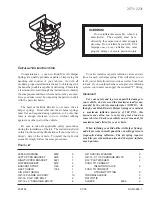
DRIVING YOUR HYUNDAI
2- 11
C190B01S-AAT
Trailer Hitches
Select the proper hitch and ball combination,
making sure that its location is compatible with
that of the trailer or vehicle being towed.
Use a quality non-equalizing hitch which distrib-
utes the tongue load uniformly throughout the
chassis.
The hitch should be bolted securely to the car
and installed by a qualified technician. DO NOT
USE A HITCH DESIGNED FOR TEMPORARY
INSTALLATION AND NEVER USE ONE THAT
ATTACHES ONLY TO THE BUMPER.
C190D01A-AAT
Safety Chains
Should the hitch connection between your car
and the trailer or vehicle you are towing fail, the
trailer or vehicle could wander dangerously
across other lanes of traffic and ultimately leave
the roadway. To eliminate this potentially dan-
gerous situation, safety chains, attached be-
tween your car and the trailer or towed vehicle,
are required in most states.
C190C01Y-AAT
Trailer Brakes
If your trailer is equipped with a braking system,
make sure it conforms to federal and/or local
regulations and that it is properly installed and
operating correctly.
NOTE:
If you tow a trailer or vehicle, your car will
require more frequent maintenance due to
the additional load. See Maintenance Under
Severe Usage Conditions” on page 5-5.
CAUTION:
o Never connect a trailer brake system di-
rectly to the vehicle brake system.
o When towing a trailer on steep grades (in
excess of 12%) pay close attention to the
engine coolant temperature gauge to en-
sure the engine does not overheat. If the
needle of the coolant temperature gauge
moves across the dial towards “H” (HOT),
pull over and stop as soon as it is safe to
do so, and allow the engine to idle until it
cools down. You may proceed once the
engine has cooled sufficiently.
CAUTION:
Do not do any towing with your car during
its first 1,200 miles (2,000 km) in order to
allow the engine to properly break in. Fail-
ure to heed this caution may result in seri-
ous engine or transaxle damage.
C190E01L-AAT
Trailer Weight Limit
Tongue load
Total trailer weight
SSA2200B
o Keep the tongue load 10% of the total trailer
load.
o Tongue load
Total trailer weight
o Tongue loads can be increased or decreased
by re-distributing the load in the trailer.
This can be verified by checking the total
weight of the loaded trailer and then check-
ing the load on the tongue.
NOTE:
1. Never load the trailer with more weight in
the back than in the front. About 60% of
the trailer load should be in the front half
on the trailer and the remaining 40% in
the rear.
2. The total gross vehicle weight with trailer
must not exceed the Gross Vehicle Weight
Rating (GVWR) shown on the vehicle
identification plate (see page 8-1). The
x 100 = 10% (MAX)
















































